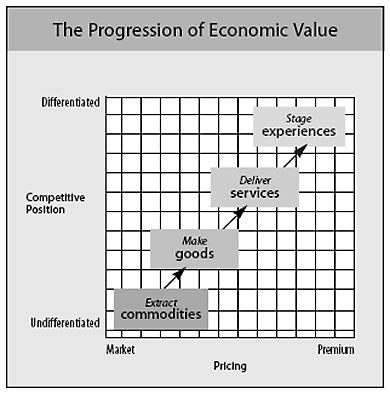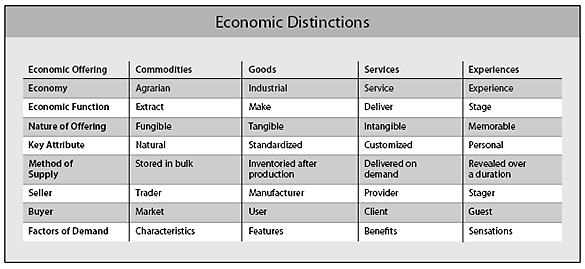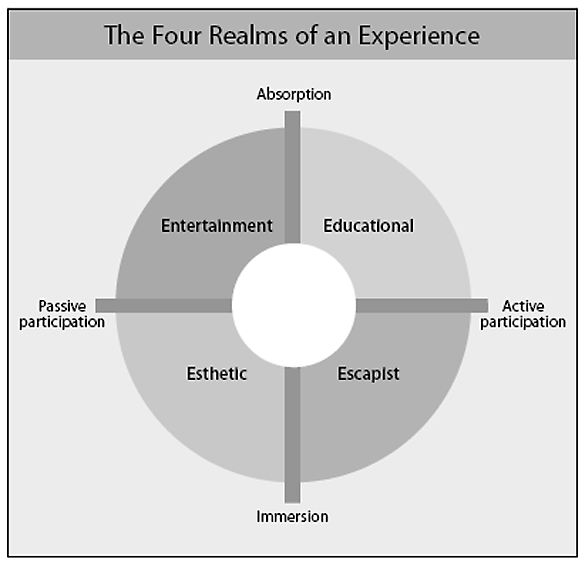Research: Welcome to the experience economy

Paper (1998) by: B. Joseph Pine II and James H. Gilmore. Source: https://hbr.org/1998/07/welcome-to-the-experience-economy.
I have read the paper so you don't have to. The 5 biggest lessons that teach you about the essence of hospitality, tourism and leisure management.
The entire history of economic progress can be recapitulated in the four-stage evolution of the birthday cake. As a vestige of the agrarian economy, mothers made birthday cakes from scratch, mixing farm commodities (flour, sugar, butter, and eggs) that together cost mere dimes.
As the goods-based industrial economy advanced, moms paid a dollar or two to Betty Crocker for premixed ingredients. Later, when the service economy took hold, busy parents ordered cakes from the bakery or grocery store, which at $10 or $15, cost ten times as much as the packaged ingredients.
Now, in the time-starved 1990s, parents neither make the birthday cake nor even throw the party. Instead, they spend $100 or more to "outsource" the entire event. [...] Welcome to the experience economy.
Economists have typically lumped experiences in with services, but experiences are a distinct economic offering, as different from services as services are from goods.
As services, like goods before them, increasingly become commoditized [...] experiences have emerged as the next step in what we call the progression of economic value.

An experience is not an amorphous construct; it is as real an offering as any service, good, or commodity. In today's service economy, many companies simply wrap experiences around their traditional offerings to sell them better. To realize the full benefit of staging experiences, however, businesses must deliberately design engaging experiences that command a fee.
An experience occurs when a company intentionally uses services as the stage, and goods as props, to engage individual customers in a way that creates a memorable event. Commodities are fungible, goods tangible, services intangible, and experiences memorable.

Buyers of experiences - we'll follow the lead of experience-economy pioneer Walt Disney and call them "guests" - value what the company reveals over a duration of time.
While prior economic offerings - commodities, goods, and services - are external to the buyer, experiences are inherently personal, existing only in the mind of an individual who has been engaged on an emotional, physical, intellectual, or even spiritual level. Thus, no two people can have the same experience, because each experience derives from the interaction between the staged event (like a theatrical play) and the individual's state of mind.
But experiences are not exclusively about entertainment; companies stage an experience whenever they engage customers in a personal, memorable way.
In the travel business [...] the "commodity mind-set" is to "think that a business is merely performing a function. [...] Transporting people from point A to point B on time and at the lowest possible price. [While an experience mind-set is about] going beyond the function and compete on the basis of providing an experience.
Experiences, like goods and services, have their own distinct qualities and characteristics and present their own design challenges.
One way to think about experiences is across two dimensions.
- Customer participation - Passive participation versus active participation
- Connection/ environmental relationship - Absorption versus immersion
We can sort experiences into four broad categories according to where they fall along the spectra of the two dimensions: Entertainment, educational events, escapist experiences and the esthetic.

We expect that experience design will become as much a business art as product design and process design are today. Indeed, design principles are already apparent from the practices of and results obtained by companies that have (or nearly have) advanced into the experience economy. We have identified five key experience-design principles.
- Theme the experience - An effective theme is concise and compelling. The theme must drive all the design elements and staged events of the experience toward a unified story line that wholly captivates the customer.
- Harmonize impressions with positive cues - While the theme forms the foundation, the experience must be rendered with indelible impressions. To create the desired impressions, companies must introduce cues that affirm the nature of the experience to the guest.
- Eliminate negative cues - Ensuring the integrity of the customer experience requires more than the layering on of positive cues. Experience stagers also must eliminate anything that diminishes, contradicts, or distracts from the theme.
- Mix in memorabilia - If service businesses like airlines, banks, grocery stores, and insurance companies find no demand for memorabilia, it's because they do not stage engaging experiences. But if these businesses offered themed experiences layered with positive cues and devoid of negative cues, their guests would want and would pay for memorabilia to commemorate their experiences.
- Engage all five senses - The sensory stimulants that accompany an experience should support and enhance its theme. The more senses an experience engages, the more effective and memorable it can be.
It's the cues that make the impressions that create the experience in the customer's mind. Even the smallest cue can aid the creation of a unique experience. When a restaurant host says, "Your table is ready," no particular cue is given. But when a Rainforest Cafe host declares, "Your adventure is about to begin," it sets the stage for something special.



